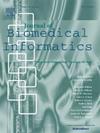How well do multimodal LLMs interpret CT scans? An auto-evaluation framework for analyses
IF 4.5
2区 医学
Q2 COMPUTER SCIENCE, INTERDISCIPLINARY APPLICATIONS
引用次数: 0
Abstract
Objective:
This study introduces a novel evaluation framework, GPTRadScore, to systematically assess the performance of multimodal large language models (MLLMs) in generating clinically accurate findings from CT imaging. Specifically, GPTRadScore leverages LLMs as an evaluation metric, aiming to provide a more accurate and clinically informed assessment than traditional language-specific methods. Using this framework, we evaluate the capability of several MLLMs, including GPT-4 with Vision (GPT-4V), Gemini Pro Vision, LLaVA-Med, and RadFM, to interpret findings in CT scans.
Methods:
This retrospective study leverages a subset of the public DeepLesion dataset to evaluate the performance of several multimodal LLMs in describing findings in CT slices. GPTRadScore was developed to assess the generated descriptions (location, body part, and type) using GPT-4, alongside traditional metrics. RadFM was fine-tuned using a subset of the DeepLesion dataset with additional labeled examples targeting complex findings. Post fine-tuning, performance was reassessed using GPTRadScore to measure accuracy improvements.
Results:
Evaluations demonstrated a high correlation of GPTRadScore with clinician assessments, with Pearson’s correlation coefficients of 0.87, 0.91, 0.75, 0.90, and 0.89. These results highlight its superiority over traditional metrics, such as BLEU, METEOR, and ROUGE, and indicate that GPTRadScore can serve as a reliable evaluation metric. Using GPTRadScore, it was observed that while GPT-4V and Gemini Pro Vision outperformed other models, significant areas for improvement remain, primarily due to limitations in the datasets used for training. Fine-tuning RadFM resulted in substantial accuracy gains: location accuracy increased from 3.41% to 12.8%, body part accuracy improved from 29.12% to 53%, and type accuracy rose from 9.24% to 30%. These findings reinforce the hypothesis that fine-tuning RadFM can significantly enhance its performance.
Conclusion:
GPT-4 effectively correlates with expert assessments, validating its use as a reliable metric for evaluating multimodal LLMs in radiological diagnostics. Additionally, the results underscore the efficacy of fine-tuning approaches in improving the descriptive accuracy of LLM-generated medical imaging findings.

多模态llm如何解释CT扫描?用于分析的自动评估框架
目的:本研究引入了一种新的评估框架GPTRadScore,以系统地评估多模态大语言模型(MLLMs)在从CT成像中产生临床准确结果方面的表现。具体来说,GPTRadScore利用llm作为评估指标,旨在提供比传统语言特定方法更准确和临床信息的评估。使用该框架,我们评估了几种mllm的能力,包括GPT-4 with Vision (GPT-4V)、Gemini Pro Vision、llva - med和RadFM,以解释CT扫描结果。方法:本回顾性研究利用公共DeepLesion数据集的一个子集来评估几种多模态llm在描述CT切片结果方面的表现。GPTRadScore的开发是为了使用GPT-4评估生成的描述(位置、身体部位和类型),以及传统的指标。RadFM使用DeepLesion数据集的一个子集进行微调,其中包含针对复杂发现的附加标记示例。微调后,使用GPTRadScore对性能进行重新评估,以衡量精度的提高。结果:评估显示GPTRadScore与临床医生的评估高度相关,Pearson相关系数分别为0.87、0.91、0.75、0.90和0.89。这些结果突出了GPTRadScore相对于传统指标(如BLEU、METEOR和ROUGE)的优越性,并表明GPTRadScore可以作为一种可靠的评估指标。使用GPTRadScore,可以观察到,虽然GPT-4V和Gemini Pro Vision的表现优于其他模型,但仍有很大的改进空间,主要是由于用于训练的数据集的局限性。微调RadFM带来了显著的精度提升:位置精度从3.41%提高到12.8%,身体部位精度从29.12%提高到53%,类型精度从9.24%提高到30%。这些发现强化了微调RadFM可以显著提高其性能的假设。结论:GPT-4与专家评估有效相关,验证了其作为评估放射诊断中多模态llm的可靠指标的使用。此外,结果强调了微调方法在提高llm生成的医学成像结果的描述准确性方面的功效。
本文章由计算机程序翻译,如有差异,请以英文原文为准。
求助全文
约1分钟内获得全文
求助全文
来源期刊

Journal of Biomedical Informatics
医学-计算机:跨学科应用
CiteScore
8.90
自引率
6.70%
发文量
243
审稿时长
32 days
期刊介绍:
The Journal of Biomedical Informatics reflects a commitment to high-quality original research papers, reviews, and commentaries in the area of biomedical informatics methodology. Although we publish articles motivated by applications in the biomedical sciences (for example, clinical medicine, health care, population health, and translational bioinformatics), the journal emphasizes reports of new methodologies and techniques that have general applicability and that form the basis for the evolving science of biomedical informatics. Articles on medical devices; evaluations of implemented systems (including clinical trials of information technologies); or papers that provide insight into a biological process, a specific disease, or treatment options would generally be more suitable for publication in other venues. Papers on applications of signal processing and image analysis are often more suitable for biomedical engineering journals or other informatics journals, although we do publish papers that emphasize the information management and knowledge representation/modeling issues that arise in the storage and use of biological signals and images. System descriptions are welcome if they illustrate and substantiate the underlying methodology that is the principal focus of the report and an effort is made to address the generalizability and/or range of application of that methodology. Note also that, given the international nature of JBI, papers that deal with specific languages other than English, or with country-specific health systems or approaches, are acceptable for JBI only if they offer generalizable lessons that are relevant to the broad JBI readership, regardless of their country, language, culture, or health system.
 求助内容:
求助内容: 应助结果提醒方式:
应助结果提醒方式:


